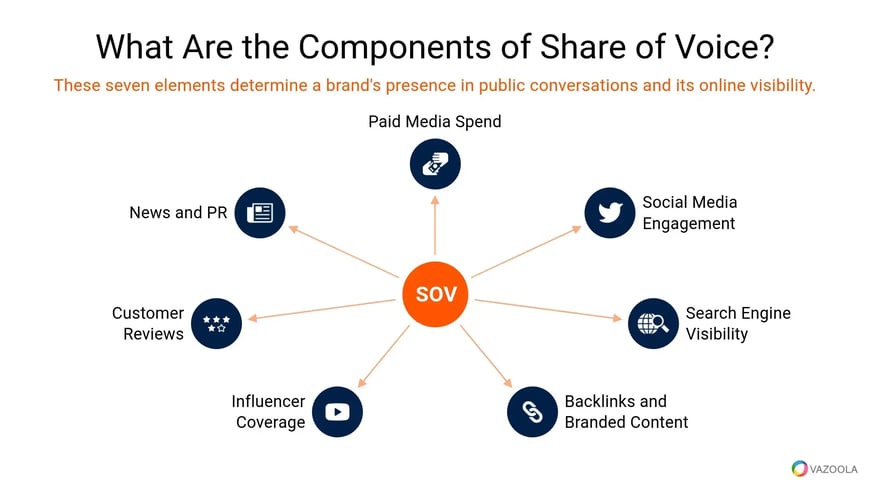How AI is Reshaping Share of Voice in Marketing
Jun 05, 2025
Written by Casey Bjorkdahl

Casey Bjorkdahl is one of the pioneering thought leaders in the SEO community. In 2010, Casey co-founded Vazoola after working for a Digital Marketing Agency for five years in New York City. Vazoola is now one of the fastest growing and most widely recognized SEO marketing firms in the country.

Artificial intelligence is everywhere we look.
The technology is even changing how marketers approach nearly every aspect of strategy… and share of voice is no exception. What once relied on simple ad spend comparisons now demands more advanced insights. With AI-powered tools, teams can evaluate their brand's visibility across search engines, social media, digital ads, and earned media in real time.
For agencies, marketing managers, content creators, and business owners, understanding this shift is essential. AI doesn't just provide new data points. It transforms how brands compete, communicate, and capture attention in a crowded digital space.
As companies seek to build links to branded content, AI is helping them measure and improve their share of the digital conversation.

Key Takeaways
-
Share of voice now includes visibility across search, social, and content — not just ad spend.
-
AI enables real-time tracking, sentiment analysis, and deeper insights into audience engagement.
-
Brands can use AI to optimize content, monitor competitors, and react faster to changes in visibility.
Table of Contents
Understanding Share of Voice
What do you know about share of voice? How has it been used in the past? Understanding the answers to these questions, as well as the components of SOV and its calculation methods, will help you prepare to introduce AI into your own strategy.
What Is Share of Voice?
What does share of voice mean, anyway?
Share of voice is a metric used to determine how much attention a brand earns in a given market or industry compared to competitors. It reflects brand visibility across various channels and is a strong indicator of market presence and marketing effectiveness. The higher your SOV, the more dominant your brand is in consumer conversations.
In the past, SOV was primarily tied to media spend, or how much a brand invested in advertising compared to others in its category. This method gave marketers a rough sense of visibility in traditional media environments.
Over time, the scope expanded. Marketers began applying the SOV model to digital channels, including organic search, social media, influencer mentions, and content marketing. This evolution made SOV a broader and more dynamic metric in the digital age.
But what about share of search vs. share of voice? What’s the difference?
While SOV focuses on a brand’s overall visibility across different media channels – including paid advertising, social media, and traditional media – SOS measures a brand's visibility in search engine results. The metric reflects both consumer interest and search behavior.
Share of Voice Components
SOV now depends on a mix of digital and traditional marketing factors. These elements help determine how much presence a brand has in public conversations and online visibility.

Common components include:
-
Paid media spend
-
Social media engagement and mentions
-
Search engine visibility
-
Backlinks and branded content
-
Customer reviews
-
News or PR coverage
Each component contributes to the bigger picture of brand reach, influence, and recognition.

Review the tone, content, and format of top-performing posts that mention your brand positively. Use AI tools to compare these against neutral or negative mentions, then adapt your messaging strategy to match what’s already working in the field.
SOV Calculation Methods
Traditional SOV calculations focused on ad spend. The formula was straightforward: Divide your brand’s ad spend by the total spend in your market and multiply by 100 to get a percentage.
Today, SOV measurement is more sophisticated. It includes search ranking data, backlink volume, branded mentions, and engagement metrics.
Modern SOV tools use machine learning and real-time tracking to calculate visibility across multiple sources. These methods offer a clearer view of how your brand is performing relative to others across organic and paid channels.

Include SOV metrics in your marketing performance dashboards and quarterly reviews. When combined with lead generation, pipeline growth, or sales data, SOV adds valuable context for decision-making and budget planning.
AI's Role in Share of Voice
Artificial intelligence is helping marketers measure SOV faster and with more precision. AI tools can scan billions of data points across digital channels, track keyword usage, analyze sentiment, and summarize competitive performance. These tools reduce manual effort and provide actionable insights much faster than traditional analytics.
AI is especially useful when measuring SOV in fast-changing environments. Whether it’s a social media trend or a search engine algorithm shift, AI can detect and flag changes in brand performance almost instantly.

AI Tools and Technologies
What are some AI-powered tools that help measure share of voice? Some examples include:
- Natural Language Processing to understand sentiment and context in brand mentions.
- AI-powered content monitoring tools like Brandwatch or Sprinklr.
- SEO platforms like SEMrush or Ahrefs that analyze keyword rankings and content performance.
- Social listening tools like Brand24 and Buzzsumo that track conversations across multiple networks in real time.

Why Use AI to Measure SOV?
AI is redefining visibility metrics by providing faster, multi-layered analysis that integrates seamlessly across platforms. Measuring share of voice with AI offers various benefits.

Accuracy
Machine learning reduces error and captures subtle brand mentions that older methods may miss.
Efficiency
Automated tools save time by eliminating the need for manual data collection.
Deeper Insights
AI helps identify trends, map audience sentiment, and pinpoint competitor weaknesses.
Real-Time Reporting
Marketers can make adjustments quickly based on current data.
Cross-Channel Tracking
AI consolidates performance data from paid, earned, and owned media.

Use AI to surface rising platforms (such as new forums, social apps, or podcast verticals) where your competitors have limited presence. Entering early helps you dominate the conversation and grow your SOV in uncontested spaces.
Tips for Optimizing Your Brand to Capture a Better Share of Voice
To improve your SOV, it’s important to combine foundational marketing practices with intelligent automation. AI tools offer several ways to optimize how your brand shows up across channels.

Understand Your Audience
AI helps brands build detailed customer profiles using real-time behavioral and demographic data. These insights enable personalized campaigns that speak directly to what audiences want. When you understand audience preferences, you can target content and timing for maximum impact.
Optimize Content
For better content optimization, AI tools can suggest topics based on search trends, competitor activity, and engagement data. They also help fine-tune messaging for clarity, tone, and SEO performance. AI supports scalable content creation by identifying what’s working—and where improvements are needed.
Build Links to Branded Content
AI tools support link-building strategies by identifying high-value backlink opportunities and analyzing anchor text effectiveness. Brands can focus on securing links from sites that contribute to authority, trust, and visibility. This strengthens domain relevance and supports long-term SOV growth.
Employ Engagement Strategies
AI chatbots, automated email campaigns, and predictive messaging tools all enhance customer interaction across touchpoints. These tools adjust tone, timing, and delivery based on user behavior, increasing engagement and strengthening brand presence.
Conduct Monitoring and Analytics
AI-powered dashboards give marketing teams constant access to data analytics and performance insights. These tools can track brand mentions, SOV fluctuations, and campaign ROI. Alerts can be configured to trigger when metrics rise or fall, allowing marketers to react without delay.
Complete Competitive Analysis
AI makes it easier to evaluate competitor backlinks, content, keyword targeting, and engagement patterns. These insights reveal areas where your brand can stand out or improve. By comparing SOV scores directly, marketers can benchmark growth and fine-tune strategy accordingly.

Don’t limit your SOV tracking to your overall brand. Segment your analysis by product category or service vertical. AI can help you pinpoint which areas are lagging in visibility and which ones deserve heavier promotion or repositioning.
More Than Ad Spend
Share of voice has evolved far beyond ad spend. Today, it spans search, social, content, and consumer engagement.
Artificial intelligence is helping brands measure and improve SOV with more precision, speed, and accuracy than ever before. From content optimization to real-time competitor tracking, AI offers the tools marketing teams need to thrive in a competitive space.
As digital visibility becomes more important to success, marketers should embrace AI to strengthen brand presence, increase engagement, and own more of the conversation.

AI can spot patterns in competitor publishing frequency, media coverage, and campaign cycles. Use this data to plan counter-campaigns when their visibility dips, helping you take over the conversation when they go quiet.

